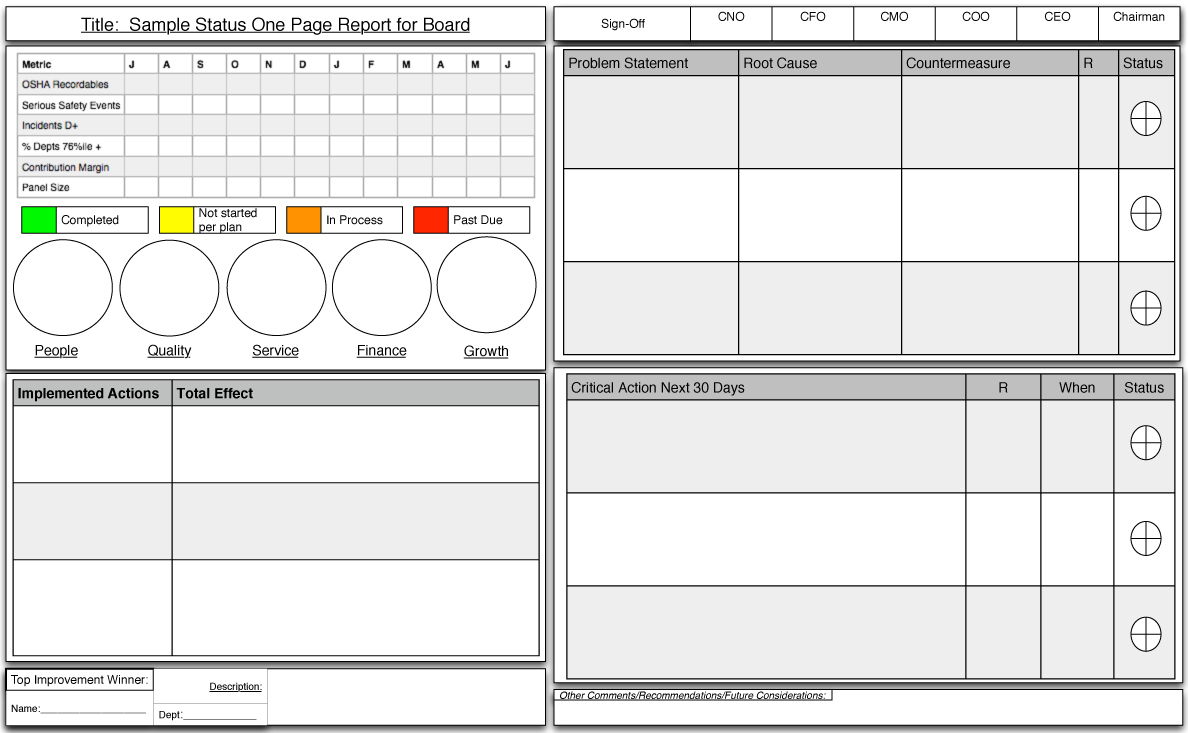Carver, in his book Your Roles and Responsibilities as a Board Member, defines responsibility as “the simple, direct responsibility for one’s own work,” and accountability as “the bottom-up accumulation of responsibility for others’ work together with one’s own.”
The total accumulation of responsibility increases from the frontline supervisor to the CEO and from the CEO to the board. Therefore, it becomes the board’s responsibility to hold the CEO accountable for holding the remainder of the senior leaders accountable, who hold the rest of the organization accountable.
If you’re implementing a lean management system that starts with senior leaders, you have targets, objectives, and actions to achieve those objectives, which I call a master plan. A master plan is a list of ~24 action items that will be implemented in order to achieve the objective. You can break this down into People, Quality, Service, Finance, and Growth.
Carver lists one of the three job products of the board of directors that cannot be delegated as “assurance of executive performance.” As a CEO, assuming you have the appropriate process of setting long term goals, targets, annual objectives, and the actions necessary to achieve the objectives – it is still ultimately the board’s responsibility to ensure that these actions as a whole are being implemented per the plan AND that they are positively affecting the performance of the organization.
The board needs to ask:
- Do you have a plan to achieve the objectives?
- Are you executing the plan?
- Is the plan working as expected?
- If not, why, and how will you adjust the plan?
As Mike Rother, author of Toyota Kata says, “Organizational routines for improvement and adaptation, NOT quantitative/financial targets, define the pathway to competitive advantage and long term organizational survival.” So why do so many boards focus on results and financial metrics rather than supporting the process through checks of achieving results?
One way for the board to hold senior leaders accountable in a lean management system is by checking the execution of the actions to achieve organizational objectives, not just results. The board needs to go far beyond checking performance measurements and actually hold senior leaders accountable for management systems and behaviors – and helping them if they need support.
As there are so many cascading actions in a lean management system, neither the board nor each chief officer can check the status of each and every action line by line and still have time for other responsibilities, the real value creating work of the organization. This is why a one page report can help.
Use a One Page Report to Increase Visibility
A deep visual dive into the status of the annual planning process is necessary to have efficient and effective check cycles with the CEO and board around each plan. A one page report is a simple visual tool that can aid in the communication process. The one page report should first contain the metrics that the organization is trying to impact and the overall status of the actions implemented for each plan.
For example – how many actions are complete, in process, or behind schedule? The next section of the OPR is for the leader(s) to articulate the total effect of implemented action items (i.e. what have we done well). The third section, the top right of the OPR, is for top problems. What are the unexpected specific problems that the organization is currently facing that will impact the results? These problems should have quick turnaround, but still usually take a month or so to have countermeasures in place and checked. The bottom right hand side of the plan is for critical action in the next 30 days. This is an operational part of the OPR that helps senior leaders negotiate and elevate actions to ensure they are communicating responsibility for a plan they have the accountability.
This type of report can be presented to a board of directors to help them understand the work being done in the organization as well as the state of the organization’s management system. It helps ensure movement is being made from frontline leadership to senior leadership on organizational objectives, master plan actions, and top organizational problems.
Below is an example of a blank one page report the senior team and CEO may use to report on the status of action plans and top problems.




